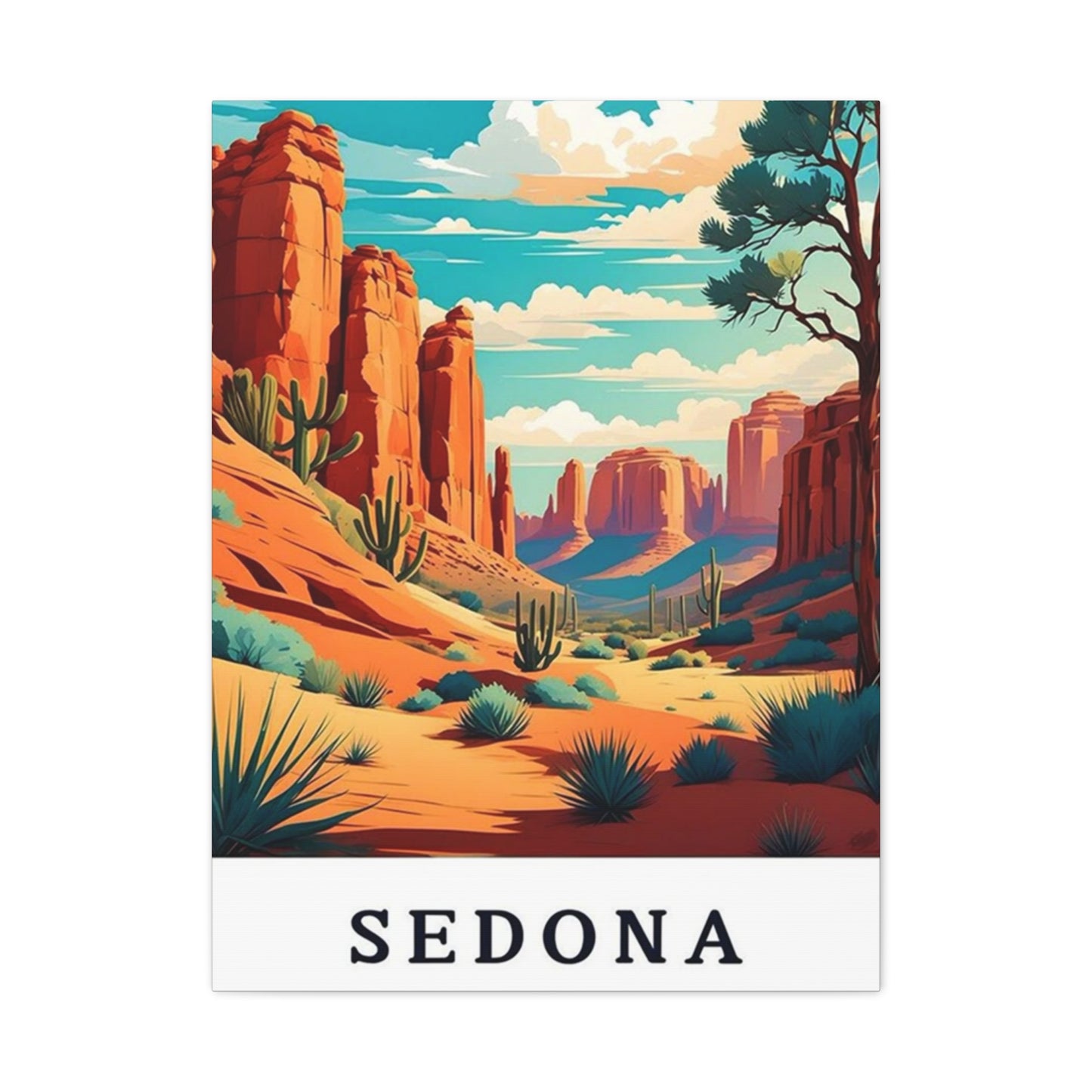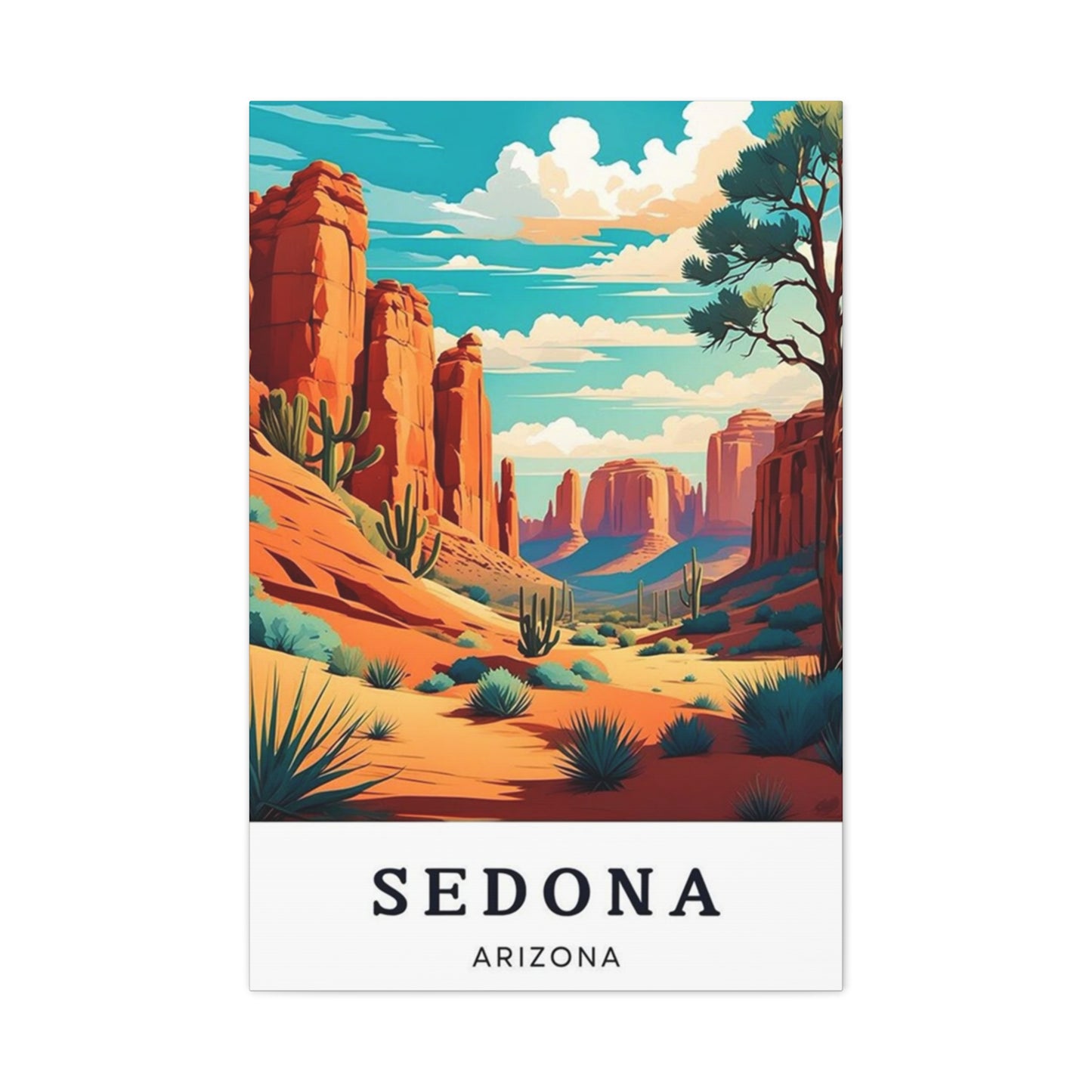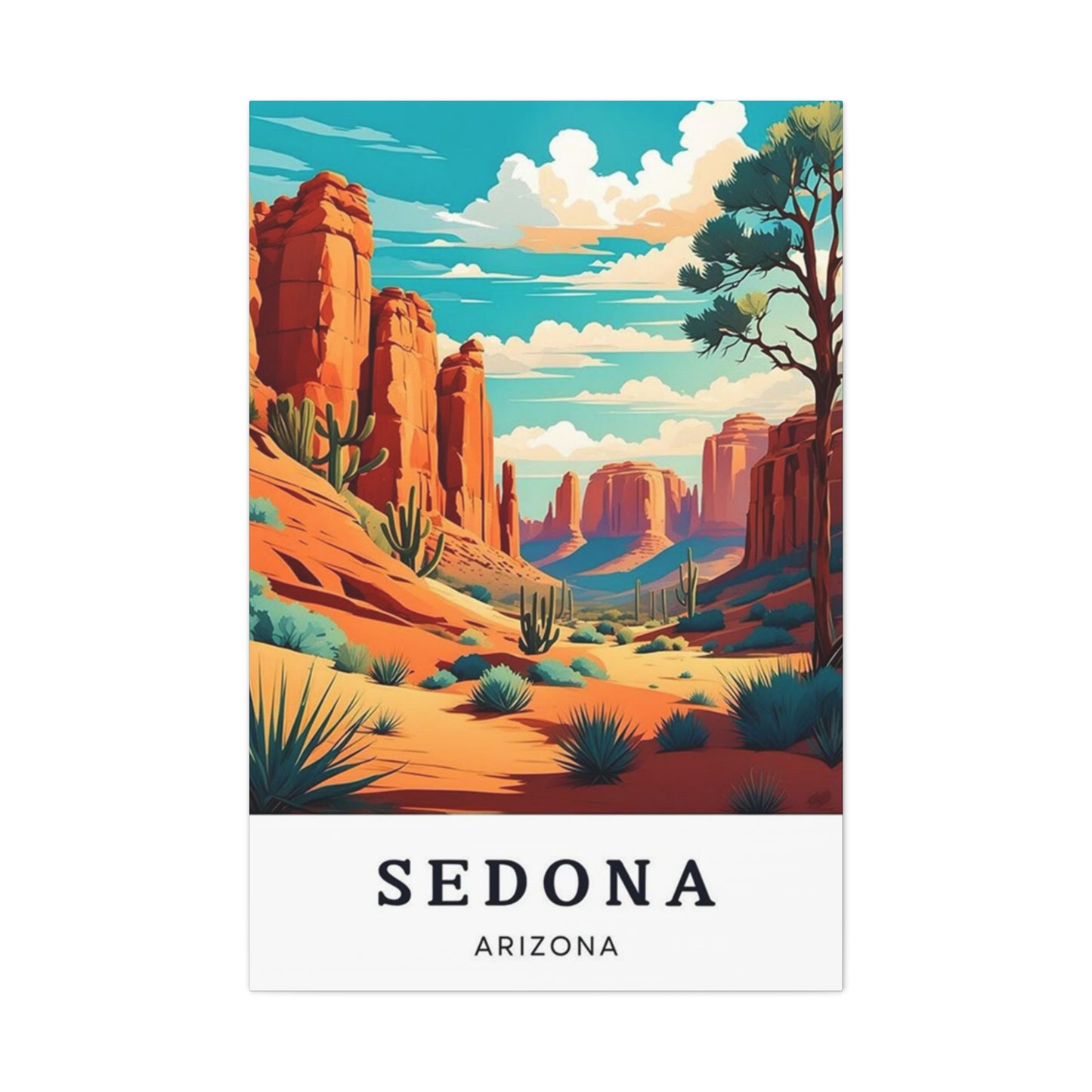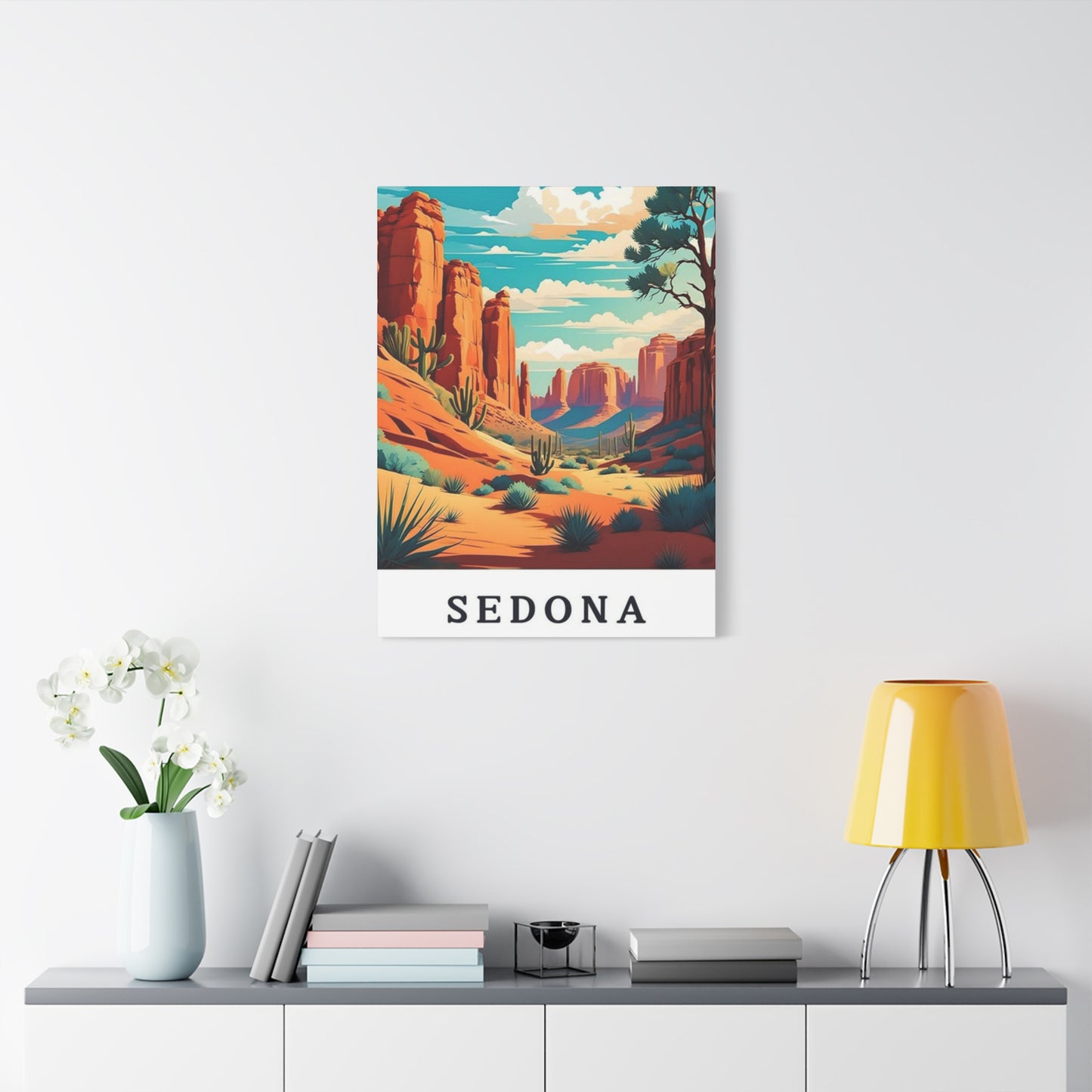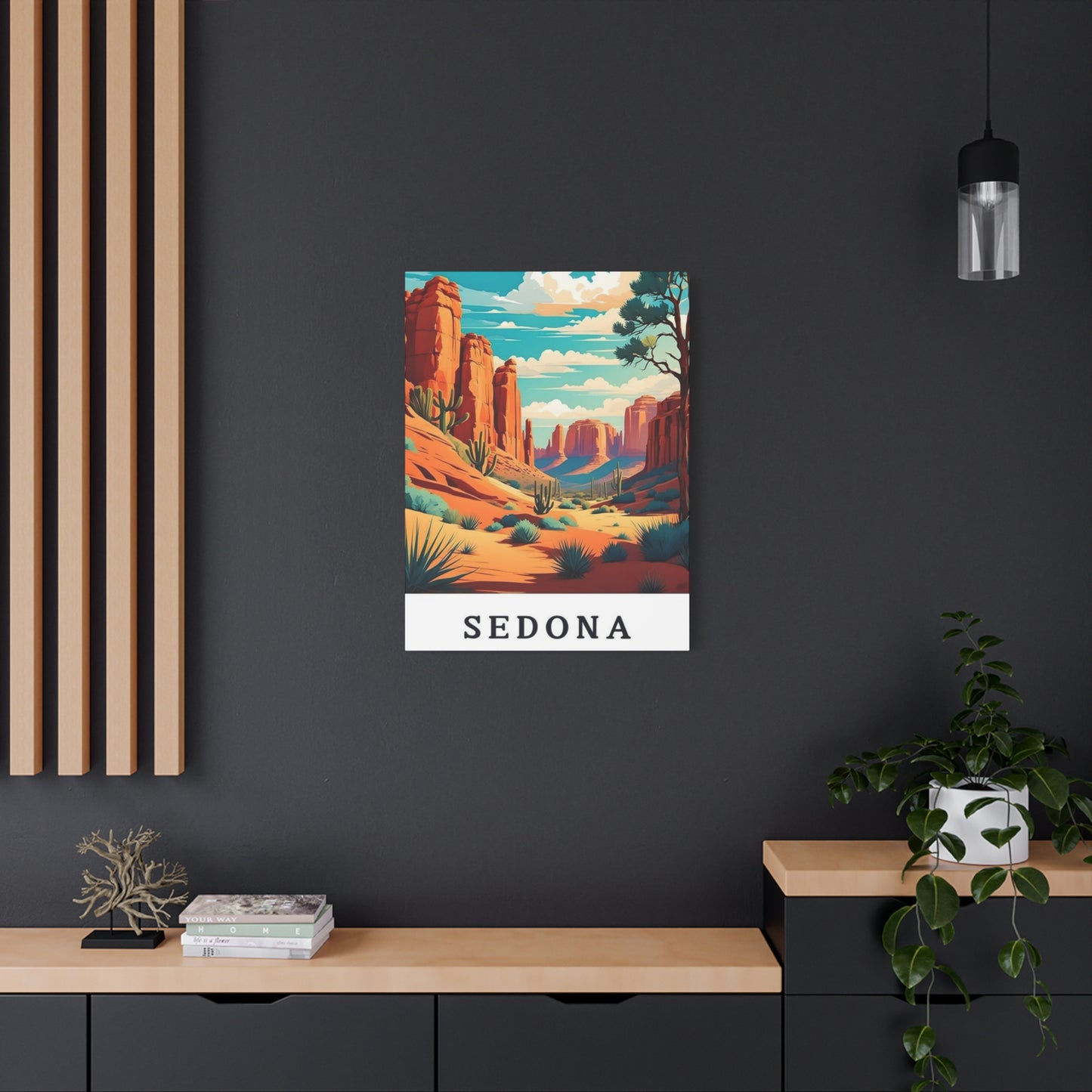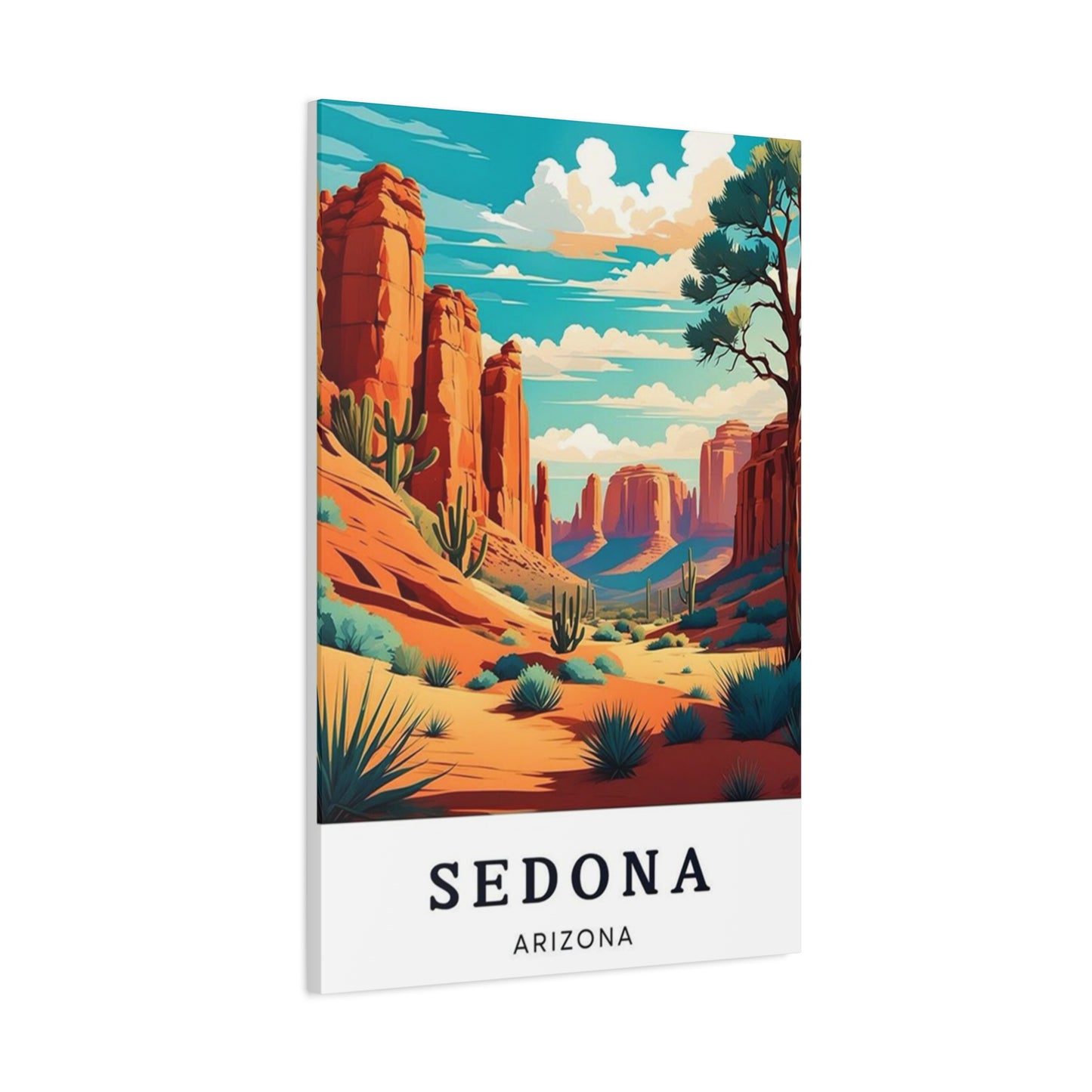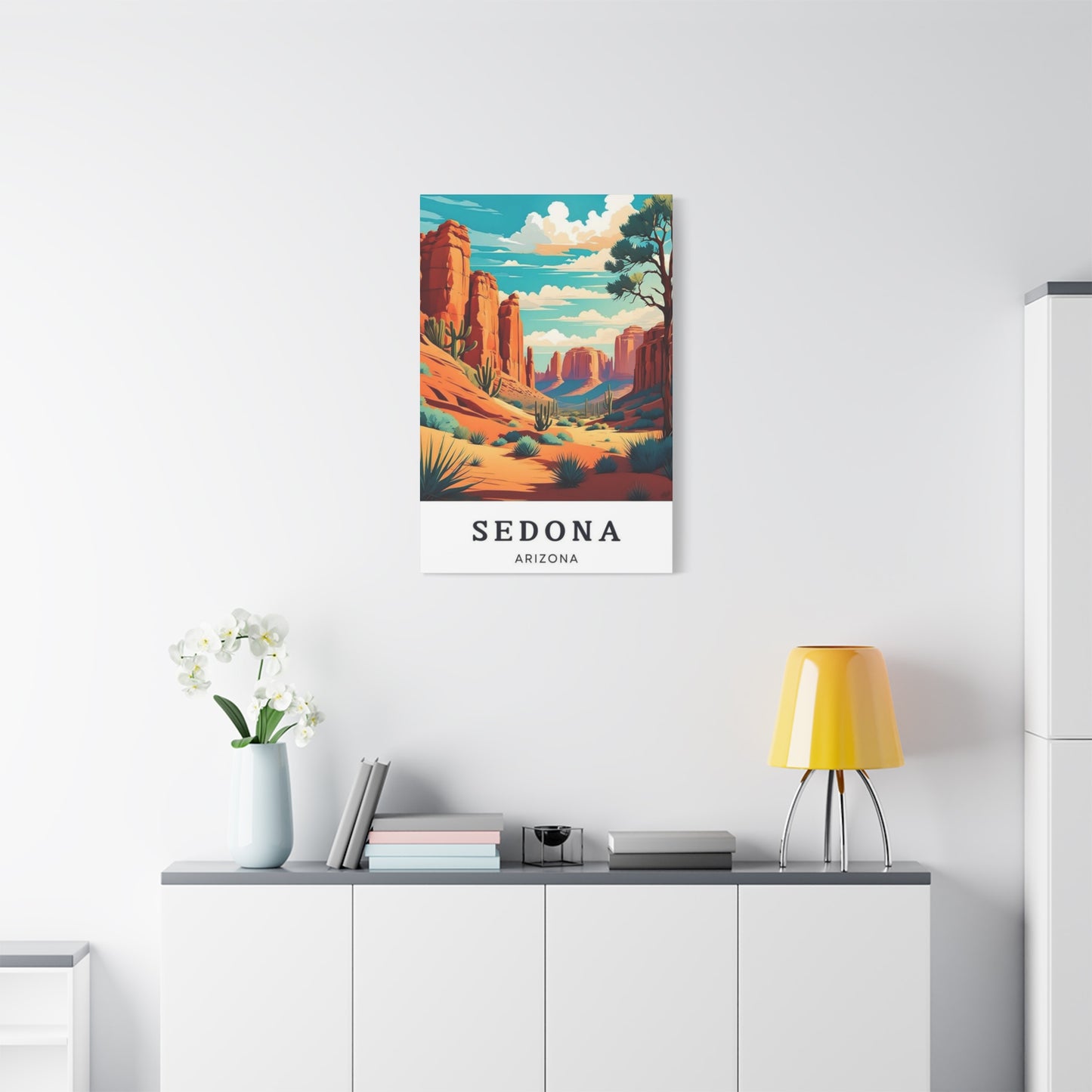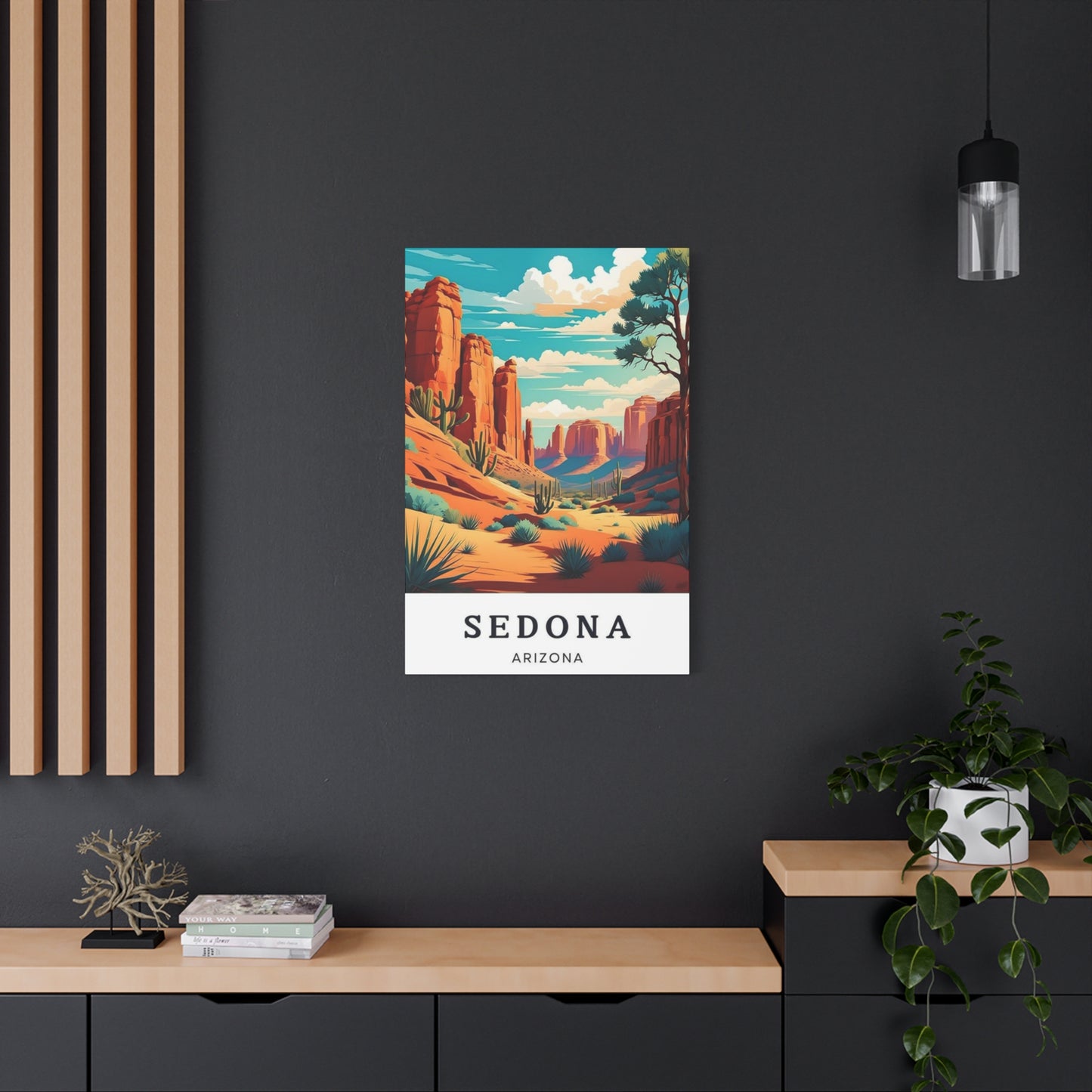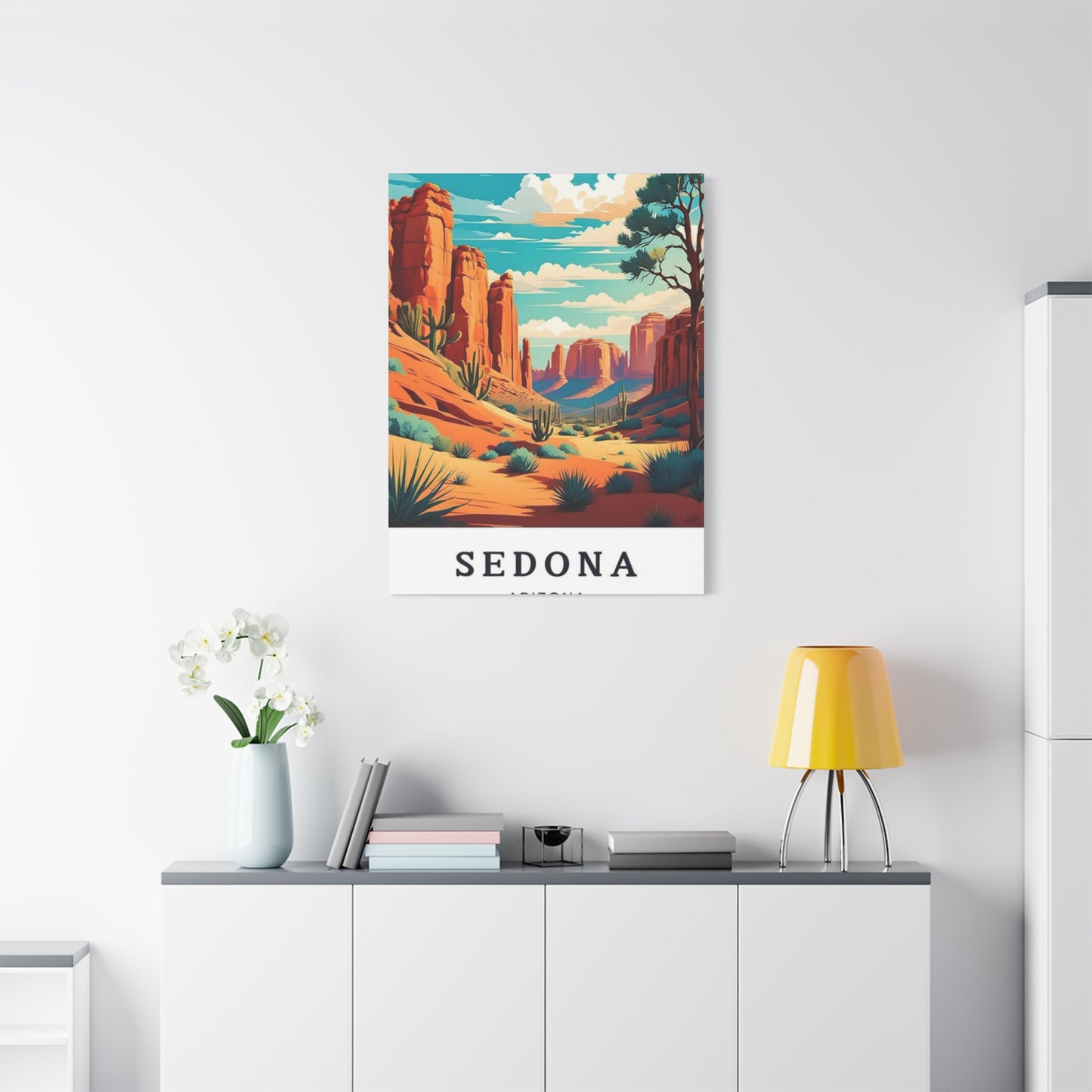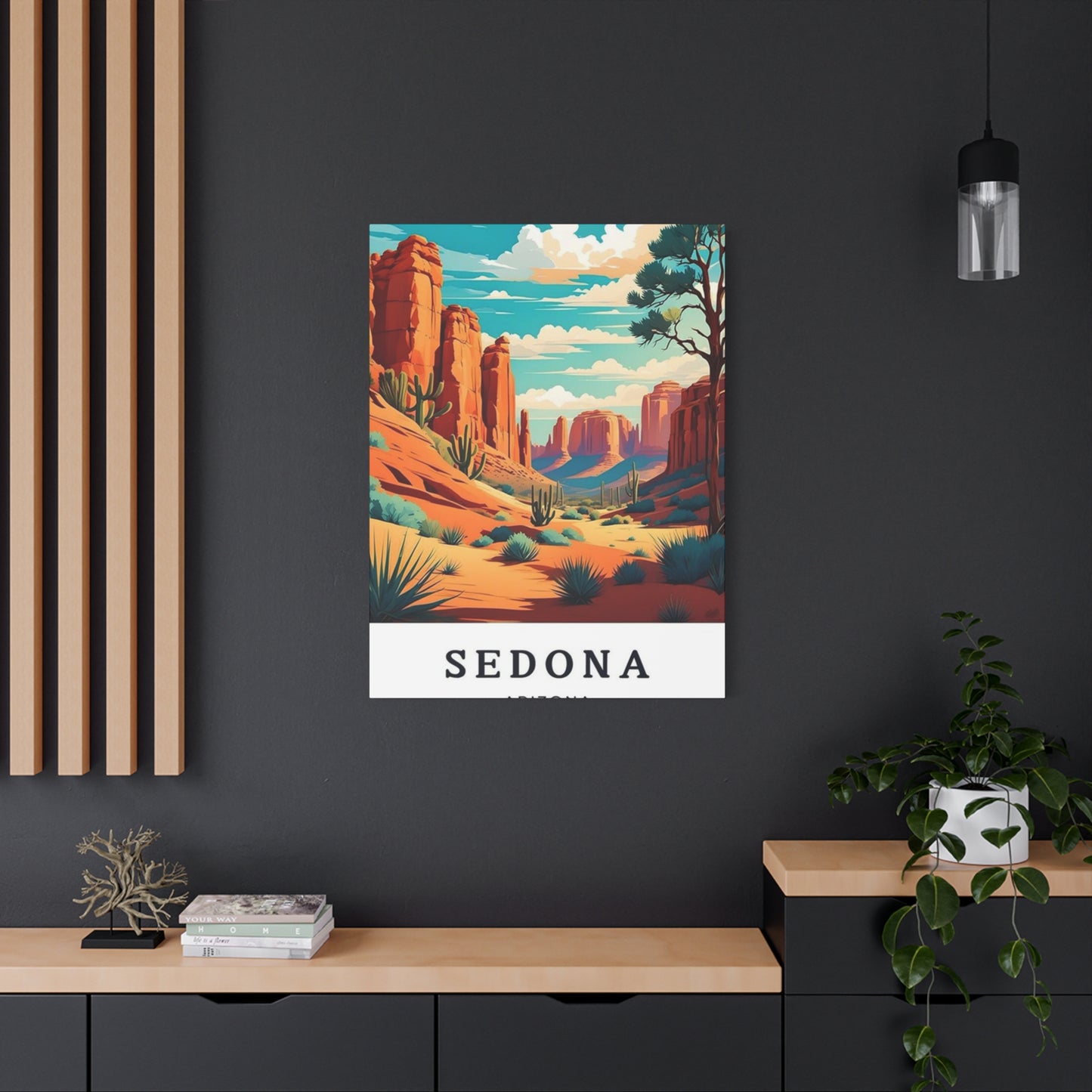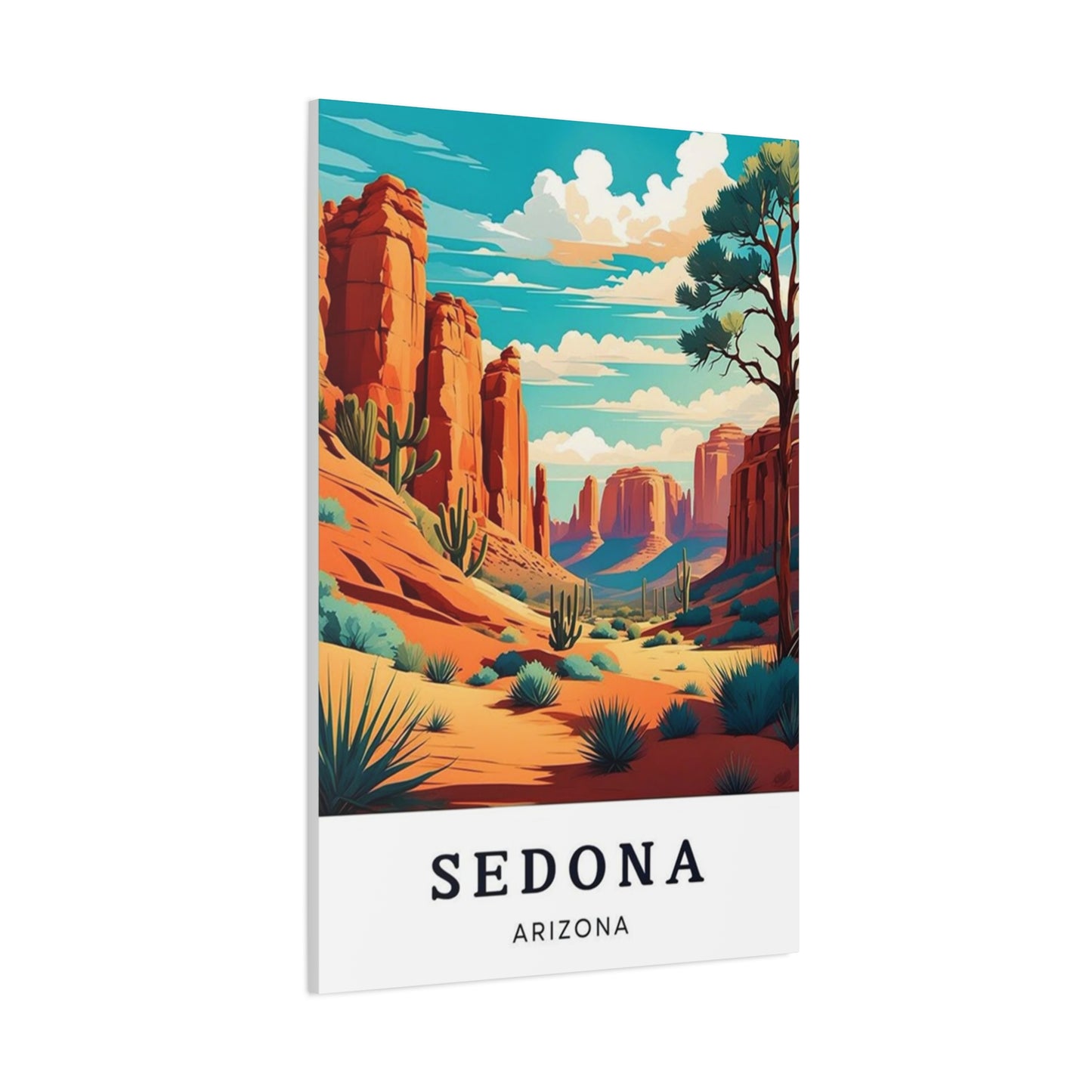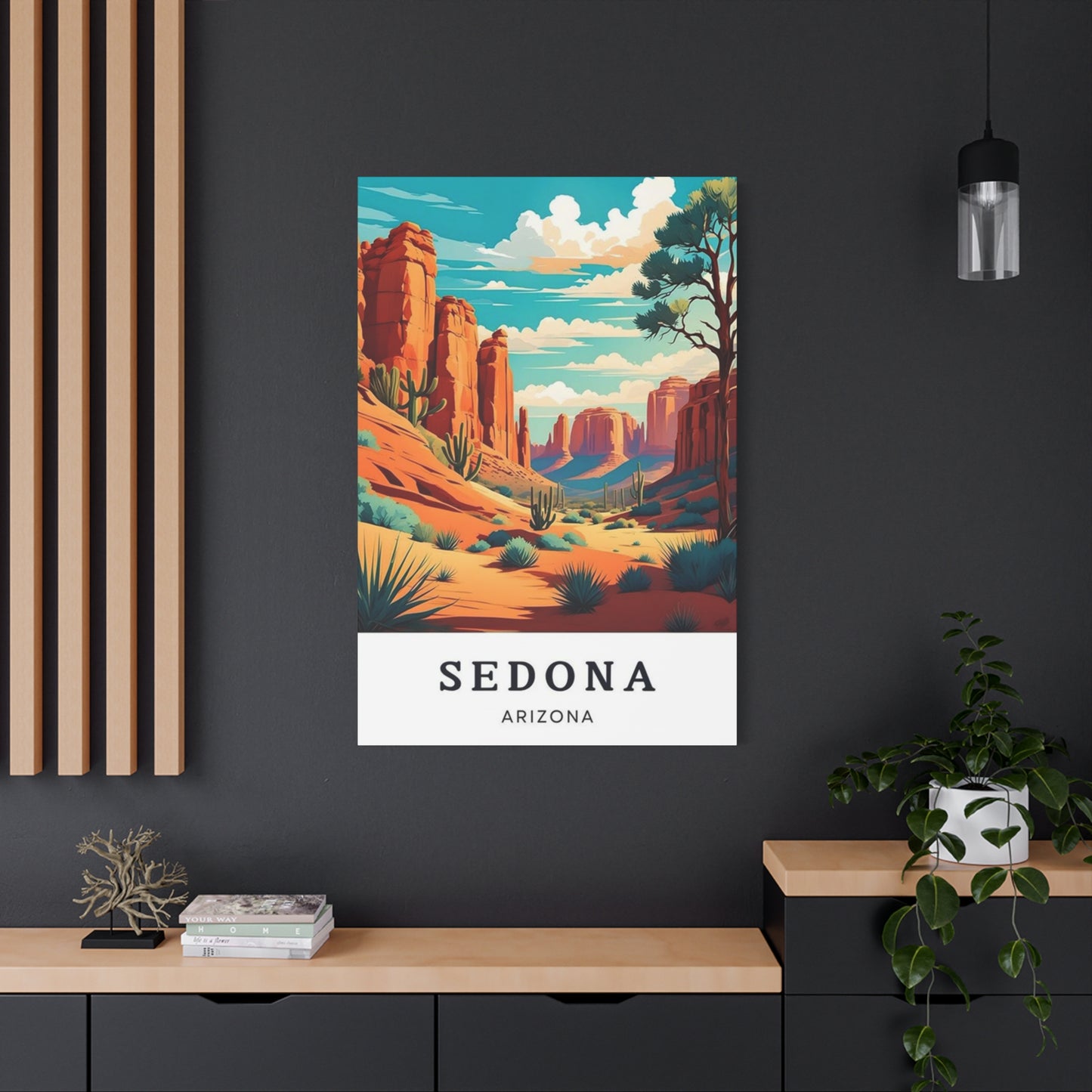The Vortex Energy of sedona arizona Wall art: Visualizing Spiritual Power on Your Walls
The majestic desert landscapes of Arizona's red rock country offer an endless source of inspiration for interior design enthusiasts and nature lovers alike. When you incorporate artwork featuring these iconic geological formations into your living space, you create an immediate connection to one of America's most breathtaking natural wonders. The russet-hued cliffs, towering stone formations, and vast desert skies provide a visual feast that translates beautifully into home décor, offering warmth, character, and a sense of adventure to any room.
Desert landscape artwork has surged in popularity over recent years as homeowners seek to bring elements of nature indoors. The distinctive formations found in central Arizona present a unique aesthetic that combines raw natural beauty with spiritual energy, making them ideal subjects for wall décor. Whether you live in a southwestern adobe home or a contemporary urban apartment, these pieces can transform your environment by introducing earthy textures, warm color palettes, and a connection to the great outdoors.
The appeal of Arizona red rock imagery extends beyond its visual beauty. These landscapes carry deep cultural significance for indigenous peoples and have become symbols of natural wonder and geological history. When you display these images in your home, you're not just adding decoration—you're celebrating millions of years of Earth's creative forces and honoring a landscape that has inspired countless artists, photographers, and spiritual seekers.
Capturing Desert Splendor Through Visual Art
The process of translating Arizona's red rock country into wall art involves careful attention to color, composition, and emotional impact. Artists and photographers who specialize in this region understand that the desert's beauty changes dramatically throughout the day, from the soft golden light of morning to the intense crimson glow of sunset. This dynamic quality makes every piece unique, offering viewers a specific moment frozen in time.
Professional photographers often spend days or even weeks in the field waiting for perfect lighting conditions to capture the desert's essence. They position themselves at strategic viewpoints where the interplay of light and shadow on ancient stone creates dramatic contrasts and reveals hidden textures. The resulting images showcase not just the physical beauty of the landscape but also its soul—the quiet majesty that has drawn people to this region for generations.
When these photographs are transformed into wall art, they maintain their ability to transport viewers to those special moments. High-quality printing techniques preserve the subtle gradations of color found in the desert rocks, from deep burgundy and burnt sienna to softer shades of pink and orange. The technical excellence of modern printing ensures that every detail—from the texture of weathered sandstone to the delicate vegetation clinging to cliffsides—remains visible and impactful.
Desert Landscape Imagery in Contemporary Interiors
Contemporary interior design increasingly embraces natural elements and organic aesthetics, making red rock imagery a perfect fit for modern homes. These pieces work exceptionally well in spaces that follow current design trends emphasizing natural materials, neutral color schemes, and connections to the outdoors. The warm earth tones found in desert photography complement popular materials like wood, stone, leather, and natural fiber textiles.
Designers appreciate how Arizona landscape art serves as both a focal point and a harmonizing element within a room. A large canvas featuring dramatic rock formations can anchor a living area, while smaller prints arranged in a gallery configuration add visual interest without overwhelming the space. The versatility of this subject matter allows it to adapt to various design styles, from minimalist Scandinavian interiors to more eclectic bohemian spaces.
The color palette of red rock landscapes offers particular advantages for interior decorating. The dominant reds, oranges, and browns provide warmth without being overpowering, while the blues and purples of desert skies add cooling contrast. These colors work harmoniously with both neutral and bold décor schemes, making them easier to incorporate than more saturated or challenging color palettes. Additionally, the natural quality of these hues creates a soothing atmosphere that promotes relaxation and contemplation.
Bringing Southwestern Character to Any Space
Southwestern design aesthetic has evolved significantly from its traditional roots, incorporating contemporary elements while maintaining connection to regional heritage. Desert landscape artwork plays a central role in this evolution, serving as a bridge between historical southwestern style and modern design sensibilities. These pieces carry the essence of the region without requiring commitment to a full southwestern décor scheme.
The incorporation of red rock imagery allows homeowners to nod to southwestern traditions while keeping their interiors fresh and current. Unlike more literal southwestern décor elements such as cacti motifs or Native American patterns, landscape photography offers sophistication and subtlety. It suggests place and atmosphere without resorting to clichéd design elements, making it suitable for those who appreciate the region's beauty but prefer a more refined aesthetic.
For those living outside the southwestern United States, these artworks offer a way to keep a cherished vacation memory alive or to celebrate a place they dream of visiting. Many people develop deep emotional connections to the red rock country after visiting, finding the landscape's unique beauty unforgettable. Displaying artwork featuring these formations allows them to maintain that connection and revisit those feelings of wonder and peace in their daily lives.
Natural Landscapes for Those Who Love the Outdoors
Outdoor enthusiasts and nature lovers find particular resonance in desert landscape artwork. These pieces speak to their appreciation for wild places and natural beauty, bringing the spirit of adventure into their homes. For hikers, rock climbers, and desert explorers, such artwork serves as both inspiration for future journeys and commemoration of past adventures in Arizona's red rock country.
The geological formations depicted in this artwork tell stories of deep time and natural processes. Each layer of rock represents millions of years of deposition, compression, and erosion. The dramatic spires, balanced rocks, and sculpted canyons result from water, wind, and time working together to create landscapes that seem almost otherworldly. Understanding this backstory adds depth to the viewing experience, transforming simple decoration into a window onto Earth's creative processes.
Nature enthusiasts appreciate artwork that captures not just the visual appearance of landscapes but also their essence and character. The best desert photography conveys the feeling of standing in these spaces—the quality of light, the vastness of sky, the texture of rock beneath your hands. This emotional authenticity separates merely pretty pictures from truly impactful art that continues to engage viewers long after the initial impression.
Rich Color Palettes in Desert Art
The color range found in Arizona's red rock formations provides artists and decorators with an incredibly rich palette. The dominant iron oxide content in the sandstone creates layers of red, ranging from pale pink to deep burgundy, while other minerals contribute yellows, whites, and even greenish hues. This natural variety means that individual pieces can emphasize different color stories depending on location, lighting, and time of day.
Canvas reproductions of desert photography benefit from modern printing technology that accurately reproduces these complex color relationships. High-quality giclée printing uses archival inks that maintain color fidelity for decades, ensuring that the warm glow of sunset on red rock or the cool shadows in a canyon remain true to the artist's vision. The texture of canvas adds another dimension, giving the printed image a tactile quality that enhances its presence in a room.
Interior designers work with these natural color palettes to create cohesive room schemes. The warm reds and oranges of rock formations pair beautifully with neutral backgrounds in cream, tan, or gray. They also complement rich wood tones in furniture and flooring, creating layers of warmth throughout a space. The blue sky often visible in desert photographs provides necessary cool contrast, preventing the overall effect from becoming monotonous or overwhelming.
Desert Photography in Rustic Interior Design
Rustic décor celebrates natural materials, handcrafted items, and connections to traditional craftsmanship. Desert landscape artwork fits seamlessly into this aesthetic, reinforcing themes of natural beauty and timeless appeal. The raw, unadorned quality of red rock formations aligns perfectly with rustic design principles that value authenticity and organic forms over polished perfection.
In rustic interiors, these artworks often appear in natural wood frames that complement the subject matter without competing for attention. Weathered or distressed frame finishes echo the aged appearance of ancient rock, creating visual continuity between frame and image. Some designers prefer to mount desert photography on wood panels rather than traditional canvas, adding another layer of natural texture and reinforcing the connection between art and material.
The combination of desert imagery with rustic furnishings creates spaces that feel grounded and authentic. Leather furniture, exposed wooden beams, stone fireplaces, and wrought iron fixtures all harmonize with red rock artwork, building a cohesive environment that celebrates natural materials and western heritage. These spaces feel welcoming and comfortable, offering refuge from the complexity of modern life through their connection to simpler, more elemental qualities.
Evening Sky Artwork Featuring Desert Formations
Sunset hours in the desert create some of nature's most spectacular displays of color and light. As the sun descends toward the horizon, it illuminates rock formations from low angles, intensifying their red hues and creating long shadows that add dramatic contrast. The sky itself becomes a canvas of changing color, moving through gold, orange, pink, and purple before deepening into twilight blue. Capturing these moments requires technical skill and artistic vision.
Photographers who specialize in sunset desert imagery often return to favorite locations repeatedly, understanding that each evening presents unique conditions. Cloud formations, atmospheric clarity, and seasonal variations all affect how light interacts with the landscape. The most memorable sunset images balance the vibrant sky with the solid presence of rock formations, creating compositions where natural elements work together rather than competing for attention.
These sunset pieces make particularly effective statement art because of their inherent drama and emotional impact. The warm colors create welcoming, energizing atmospheres in living spaces, while the natural beauty of the scene provides visual interest that doesn't tire with repeated viewing. Unlike more abstract or conceptual art, sunset landscapes offer immediate accessibility—everyone understands and appreciates the beauty of a spectacular sunset, making these pieces universally appealing.
Dramatic Rock Formations as Visual Anchors
Large-scale artwork featuring bold desert formations serves as an effective focal point in room design. These statement pieces command attention and set the tone for entire spaces, providing a visual anchor around which other design elements can be arranged. The dramatic vertical thrust of rock spires or the massive presence of canyon walls translates into powerful visual statements that transform ordinary rooms into memorable spaces.
When selecting statement artwork, scale considerations are crucial. A piece that's too small will fail to make the intended impact, while one that's oversized may overwhelm the space. Design professionals often recommend that large artwork span roughly two-thirds to three-quarters of the furniture width it hangs above, creating balanced proportions. For statement walls without furniture below, pieces can be even larger, potentially occupying a significant portion of the wall surface.
The placement of statement desert artwork affects traffic flow and room function. In living rooms, these pieces typically appear on the main wall visible from the primary seating area, creating a focal point that draws the eye and anchors conversation areas. In dining rooms, they might hang on the wall most visible from the table, providing a view that enhances the dining experience. Proper lighting, whether natural or artificial, ensures these important pieces receive the attention they deserve.
Desert Landscapes for Comfortable Living Areas
Living rooms serve as gathering spaces where families relax, entertain guests, and spend significant time together. The artwork chosen for these spaces should enhance comfort and create welcoming atmospheres. Desert landscape pieces excel in this role because of their natural warmth and the sense of expansiveness they bring to interior spaces. The open vistas depicted in these images can make rooms feel larger and more connected to the outdoors.
The psychological impact of nature imagery in living spaces has been well documented. Studies show that viewing natural landscapes can reduce stress, lower blood pressure, and improve overall mood. Desert scenes, with their emphasis on vast spaces, clear skies, and ancient geological stability, offer particular benefits. They suggest permanence, peace, and the timeless rhythms of nature—qualities that create restful environments conducive to relaxation and social connection.
Arranging furniture and décor around desert artwork requires attention to sight lines and viewing distances. Large pieces should be positioned where they can be appreciated from the primary seating areas without requiring awkward neck positions. Complementary décor elements might include throw pillows in coordinating earth tones, natural fiber rugs, potted succulents or other desert plants, and ceramics or pottery with southwestern influences. These supporting elements reinforce the theme without creating overwhelming repetition.
Regional Design Elements in Wall Décor
Southwestern design draws from multiple cultural traditions, including Native American, Spanish colonial, and Mexican influences, blended with the practical needs of desert living. Contemporary interpretations of this style emphasize clean lines and edited aesthetics while maintaining connection to regional character. Desert photography fits naturally into these spaces, providing authentic southwestern flavor without relying on stereotypical or overly literal design elements.
The key to successfully incorporating regional design elements lies in restraint and authenticity. Rather than cluttering spaces with multiple southwestern motifs, designers select a few high-quality pieces that genuinely reflect the region's character. A striking photograph of red rock formations might be the primary southwestern element in a room, supported by subtle touches like natural wood furniture, leather accents, or earth-toned textiles. This approach creates sophisticated spaces that honor southwestern heritage without becoming thematic or kitschy.
Regional artwork also provides opportunities for storytelling and personal expression. Homeowners who have traveled through the desert or who feel spiritual connections to these landscapes can use photography to share those experiences with guests. The artwork becomes a conversation starter, prompting stories about hiking adventures, memorable sunsets, or the unique energy people often report feeling in these ancient places. This personal dimension elevates decoration into meaningful expression.
Energy Centers Depicted in Artistic Works
The region surrounding Arizona's red rocks has gained fame for reported energy centers where some people claim to feel heightened spiritual or physical sensations. These locations attract seekers from around the world hoping to experience meditation, healing, or spiritual insight. Whether one accepts metaphysical explanations for these phenomena or attributes them to the power of beautiful natural settings, certain locations clearly hold special significance for many visitors.
Photographers who document these energy sites approach them with reverence and attention to atmosphere. Beyond merely recording physical appearances, they attempt to capture the quality of light, the sense of space, and the subtle environmental factors that contribute to these locations' special character. The resulting images often emphasize the intersection of earth and sky, the play of light through rock formations, or the sense of timelessness found in ancient geological structures.
For those who believe in the metaphysical properties of these sites, displaying related artwork serves as a way to maintain connection with those energies. Others simply appreciate the exceptional beauty of these locations and the skilled photography that captures them. Regardless of one's beliefs, these pieces tend to create peaceful, contemplative atmospheres in homes—perhaps because they remind viewers to pause, breathe, and appreciate natural beauty in our busy modern lives.
Photography-Based Desert Imagery for Interiors
High-quality photography offers distinct advantages as wall art. Unlike paintings or digital illustrations, photographs capture actual moments and real places, providing documentary value alongside aesthetic appeal. Desert photography, in particular, benefits from this authenticity—viewers know they're seeing actual rock formations shaped by millions of years of natural processes, real sunsets witnessed by the photographer, and genuine landscapes they could potentially visit themselves.
The technical aspects of photography-based wall art deserve consideration when making purchasing decisions. Print quality depends on multiple factors including original image resolution, printing method, paper or canvas quality, and ink longevity. Professional photographers typically work with high-resolution cameras that capture extensive detail, ensuring that even large prints remain sharp and clear. Giclée printing on archival materials produces museum-quality results that resist fading and deterioration for decades when properly displayed.
Limited edition photography offers collectors the opportunity to own unique pieces with documented scarcity. Photographers often release images in numbered editions, with each print signed and accompanied by a certificate of authenticity. While unlimited reproductions serve decorative purposes perfectly well, limited editions appeal to those who value exclusivity and potential investment value. Either option can provide years of viewing pleasure when the image genuinely resonates with the owner.
Simplified Desert Art for Contemporary Spaces
Minimalist design principles emphasize simplicity, clean lines, and careful editing of visual elements. Within this aesthetic, every item must justify its presence through function, beauty, or both. Desert landscape artwork can succeed in minimalist spaces when it shares these values—strong composition, restrained color palettes, and clear visual impact without unnecessary complexity or busy detail.
Certain photographic approaches to desert landscapes align naturally with minimalist sensibilities. Images that emphasize simple forms, negative space, and graphic compositions work particularly well. A single dramatic rock formation against clear sky, the curve of a sand dune, or the clean lines of layered rock strata can provide visual interest while maintaining the uncluttered feel essential to minimalist design. Black and white photography of desert subjects offers another avenue for minimalist expression.
Framing choices significantly impact how desert artwork functions in minimalist spaces. Simple, thin frames in black, white, or natural wood maintain focus on the image itself without adding visual weight. Some minimalists prefer frameless mounting methods that allow the artwork to appear as a simple plane on the wall. The key is ensuring that the frame or mounting enhances rather than distracts from the photograph's essential qualities and the overall room aesthetic.
Coordinating Desert Imagery with Natural Color Schemes
Earth-tone color schemes have remained popular in interior design because of their inherent versatility and timeless appeal. These palettes, based on colors found in nature—browns, tans, terracottas, olive greens, and warm grays—create comfortable, grounded spaces that work across multiple design styles. Desert landscape artwork naturally complements these color schemes because it literally depicts earth in its raw form, providing perfect tonal harmony.
When pairing desert photography with earth-tone interiors, designers consider both dominant colors and subtle accents. A room dominated by neutral tans and creams provides a calm backdrop that allows the reds and oranges in desert photography to pop without overwhelming. Conversely, spaces with darker wood tones and chocolate browns can handle more intense desert colors, creating rich, layered environments. The key is achieving balance—ensuring that artwork and surroundings enhance rather than compete with each other.
Accent colors drawn from desert photography can tie together disparate design elements throughout a room. For instance, throw pillows incorporating the rust reds from a desert photograph might coordinate with a terra cotta vase or clay pottery pieces displayed on shelving. This repetition of color creates visual cohesion that makes spaces feel intentionally designed rather than randomly decorated. The natural origin of these colors ensures they work harmoniously together, even when drawn from multiple sources.
Desert Photography for Professional Environments
Office spaces benefit from artwork that inspires, energizes, and reduces stress. Desert landscape photography serves all three functions effectively. The natural beauty captured in these images provides visual relief from computer screens and paperwork, while the sense of vast open spaces can counteract feelings of confinement that sometimes accompany office work. The warm colors typical of desert photography create welcoming atmospheres in spaces that might otherwise feel cold or impersonal.
Psychological research supports the inclusion of nature imagery in work environments. Employees with views of nature or nature-related artwork report higher job satisfaction, lower stress levels, and improved concentration. Desert landscapes, with their emphasis on endurance, timelessness, and natural majesty, can inspire perseverance and long-term thinking—valuable qualities in professional contexts. The absence of human presence in most landscape photography also provides mental escape without the distraction of narrative content.
Selecting artwork for professional spaces requires consideration of the environment's formal expectations and the impression desired. Large, impressive desert vistas suit reception areas and conference rooms where they contribute to a sense of establishment success and solid grounding. Individual offices might feature more intimate desert scenes that provide personal inspiration without demanding excessive attention. In all cases, professional-quality framing and proper installation demonstrate attention to detail and respect for the workspace.
Peaceful Atmospheres Through Natural Imagery
The modern world's constant stimulation and rapid pace create widespread desire for calm, peaceful environments where people can restore mental and emotional balance. Natural landscapes, particularly those depicting serene desert scenes, offer visual respite from daily chaos. The stillness captured in desert photography—ancient rocks that have stood for millennia, endless skies, quiet vistas empty of human activity—provides an antidote to information overload and constant connectivity.
Creating calming environments involves more than simply hanging peaceful pictures. The overall design must support tranquility through coordinated choices in color, lighting, furniture arrangement, and decorative objects. Desert photography contributes to this goal most effectively when it's part of a holistic approach. Soft, warm lighting that mimics natural conditions, comfortable seating positioned to view the artwork, and minimal clutter all enhance the calming effect of serene landscape images.
Certain desert subjects particularly promote peaceful feelings. Smooth, flowing rock formations sculpted by water over millennia suggest patience and natural processes unfolding in their own time. Wide vistas emphasizing horizontal lines and vast distances create feelings of openness and possibility. Sunset images, with their associations of day's end and natural cycles, can encourage relaxation and letting go of daily concerns. Selecting images that personally resonate ensures the calming effect remains strong over time rather than fading into background noise.
Desert Photography as Thoughtful Gifts
Finding meaningful gifts for nature enthusiasts presents challenges—how do you give something to people who value experiences over possessions? High-quality desert photography offers a solution by combining aesthetic beauty with connection to places and experiences recipients value. For those who have visited red rock country, such artwork recalls memorable trips and strengthens emotional bonds to places they love. For those who haven't yet visited, it provides inspiration and a promise of future adventures.
Gift-giving occasions where desert artwork particularly excels include housewarmings, retirements, and milestone celebrations. A carefully selected piece shows thoughtfulness and attention to the recipient's interests and preferences. Including personal touches—perhaps a note about a shared hiking memory or information about the specific location depicted—transforms the gift from simple decoration into something more meaningful. The durability and timeless quality of photographic art ensures it will provide pleasure for years.
Presentation matters when gifting artwork. Professional framing demonstrates investment in quality and saves recipients the time and expense of framing themselves. Including information about the photographer, the location depicted, and the printing methods used shows respect for both the art and the recipient. For especially meaningful gifts, limited edition prints with certificates of authenticity add an extra dimension of specialness and potential future value beyond their immediate decorative function.
Incorporating Desert Art into Home Décor
Successfully integrating desert photography into existing décor requires attention to several key factors. First, consider the room's existing color palette and whether the artwork will harmonize or provide intentional contrast. Second, evaluate available wall space and traffic patterns to determine appropriate sizes and placement locations. Third, think about lighting conditions—both natural and artificial—that will affect how the artwork appears at different times. Finally, consider the room's function and how the artwork will enhance its purpose.
Beginning with a single statement piece often works better than attempting to incorporate multiple pieces at once. This allows you to live with the artwork for a while, observing how it affects the space and your response to it. Once you're comfortable with the initial piece, you can add complementary works if desired, building a cohesive collection over time. This gradual approach prevents overwhelming spaces with too much similar imagery and allows for more thoughtful curation.
Styling around desert photography involves balancing repetition and variety. While you want supporting décor elements that harmonize with the artwork, exact matching creates static, uninspired spaces. Instead, pull accent colors from the photograph for use in textiles or decorative objects, incorporate natural materials that echo the artwork's subject, and add plants or organic forms that reference desert environments without literally duplicating them. This creates layered, interesting spaces that feel cohesively designed.
Abstract Interpretations of Desert Formations
While realistic photography dominates desert wall art, abstract interpretations offer alternative approaches that appeal to different aesthetic preferences. Abstract desert art might emphasize color relationships, geometric forms inherent in rock layers, or emotional responses to the landscape rather than literal representation. These pieces work particularly well in contemporary or modern interiors where pure decoration takes precedence over documentary representation.
Artists creating abstract desert works often focus on the essential qualities of the landscape—the interplay of warm and cool tones, the rhythm of horizontal and vertical forms, the contrast between solid earth and empty sky. By simplifying and distilling these elements, they create compositions that suggest desert character without depicting specific locations. This approach offers versatility because viewers aren't comparing the artwork to their own memories or expectations of particular places.
Combining abstract and realistic desert art in the same space can create dynamic, sophisticated gallery walls. The realistic pieces ground the collection in recognizable imagery while the abstract works add visual interest and contemporary edge. This mixing of styles demonstrates curatorial confidence and creates more engaging viewing experiences than walls featuring only similar pieces. The key is ensuring all pieces share color harmonies or thematic connections that unify the collection despite stylistic differences.
Multiple Desert Pieces Displayed Together
Gallery walls arrange multiple artworks into cohesive displays that create impact exceeding any individual piece. Desert photography lends itself beautifully to this treatment because the subject matter naturally varies—different locations, times of day, seasons, and perspectives provide visual variety while maintaining thematic unity. A well-designed gallery wall featuring desert subjects can become a room's primary focal point and a source of ongoing visual interest.
Creating successful gallery walls requires attention to both individual pieces and overall composition. Start by laying out all pieces on the floor, experimenting with arrangements until you find one that balances visual weight and creates pleasing rhythms. Consider mixing different sizes while maintaining consistent frame styles for cohesion, or using identical frames with varied content. The spacing between pieces matters as much as their arrangement—too close creates visual confusion while too far apart loses unity.
Thematic approaches to desert gallery walls offer multiple possibilities. You might focus on a single location captured at different times, showing how light and season transform familiar landscapes. Alternatively, collect diverse desert locations unified by similar color palettes or compositional approaches. Some collectors prefer mixing desert subjects with related imagery—desert flowers, wildlife, or abstract geological close-ups—to create more varied but still thematically connected displays. Whatever approach you choose, ensure the collection reflects genuine personal interest rather than generic decoration.
Desert Photography in Sleeping Spaces
Bedroom artwork requires different considerations than pieces for social spaces. Bedrooms serve as private retreats where people begin and end each day, making the emotional quality of artwork particularly important. Desert photography works exceptionally well in bedrooms because of its generally calming character and the warm, restful color palettes typical of the subject matter. Viewing peaceful desert vistas before sleep and upon waking can positively influence mood and stress levels.
Color psychology suggests that warm earth tones promote relaxation and comfort—ideal qualities for sleeping spaces. The reds, oranges, and browns predominant in desert photography fall into this category, creating cocooning environments conducive to rest. However, extremely intense or dramatic images might be overstimulating for some people in bedrooms. Gentler compositions featuring softer light and more subdued colors often work better, reserving highly dramatic pieces for social spaces where energy and impact are more appropriate.
Placement considerations in bedrooms typically center on the wall above the bed, which serves as the natural focal point. Large horizontal pieces work well in this location, though vertical pieces or diptychs can suit the space depending on bed width and wall dimensions. Some people prefer artwork on the wall opposite the bed, visible when lying down but not directly overhead. Side walls flanking the bed offer additional options, particularly for creating symmetrical arrangements or gallery collections.
Dawn and Dusk in Desert Canvas Art
The transitional periods of dawn and dusk hold special magic in desert environments. Morning light arrives gradually, painting rock formations in soft pinks and golds before strengthening into the bright clarity of day. Evening reverses this process, with direct sunlight giving way to the rich warm tones of golden hour before fading into twilight. These periods offer photographers dramatic lighting conditions and spectacular color displays that translate beautifully into canvas prints.
Canvas reproduction techniques have advanced significantly, now offering quality approaching traditional photographic prints with added textural interest. The slightly matte surface of canvas reduces glare issues that sometimes affect glossy photo papers, making canvas prints suitable for areas with challenging lighting conditions. The texture adds subtle dimensionality that enhances the physical presence of artwork, particularly in larger sizes where the canvas weave becomes part of the viewing experience.
Sunrise and sunset pieces serve different emotional purposes despite their technical similarities. Sunrise imagery suggests new beginnings, optimism, and energy—qualities that might inspire morning routines or energize workspaces. Sunset photographs evoke completion, peace, and reflection—more appropriate for relaxation areas or bedrooms. Understanding these subtle psychological associations helps in selecting appropriate images for specific spaces and purposes within your home.
Frame Selection for Desert Photography
Framing choices significantly impact how artwork functions within room design. For desert photography, frame selection should enhance the image while respecting its character and the surrounding décor. Natural wood frames in warm tones—oak, walnut, cherry, or reclaimed barnwood—complement the earth-tone color palette of desert subjects. The organic quality of wood frames creates visual harmony with natural landscape subjects, reinforcing themes of nature and authenticity.
Rustic frame finishes particularly suit desert photography. Distressed or weathered treatments echo the aged appearance of ancient rock formations, creating thematic connections between frame and content. Hand-hewn or rough-cut frames add texture and character without overwhelming the artwork. These rustic approaches work especially well in southwestern, farmhouse, or eclectic décor styles where imperfection and age are valued aesthetic qualities rather than flaws to be avoided.
Not all desert photography requires rustic framing. Contemporary spaces might call for sleek metal frames in bronze, copper, or black iron that reference southwestern materials in more refined forms. Minimalist interiors sometimes benefit from simple wood frames with clean lines and smooth finishes, or even frameless mounting methods. The key is ensuring frame and image work together successfully—the frame should feel inevitable rather than arbitrary, as though it's the only logical choice for that particular piece.
Regional Design in Modern Homes
Modern southwestern architecture and design blend traditional regional elements with contemporary aesthetics, creating spaces that honor heritage while embracing current lifestyle needs. Desert photography plays a vital role in these interiors, providing authentic connection to place without requiring commitment to historical design conventions that might feel dated or constraining. These images bridge past and present, allowing homeowners to create unique spaces that reflect personal taste rather than decorating formulas.
Contemporary southwestern homes often feature clean lines, open floor plans, and abundant natural light—characteristics that complement large-scale desert photography beautifully. Floor-to-ceiling windows frame actual desert views while interior walls display curated photographic selections that enhance and extend those views. The interplay between actual landscape visible through windows and artistic interpretations on walls creates layered experiences of place that deepen residents' connections to their environment.
For those living outside the southwest, these design principles adapt successfully to create southwestern character anywhere. Desert photography becomes the primary signifier of regional style, supported by carefully selected southwestern accessories and materials. A large desert photograph might hang above a stone fireplace, flanked by wrought iron sconces and complemented by leather furniture and clay pottery. These elements combine to suggest southwestern character without literal reproduction of historical styles, resulting in sophisticated, personal spaces.
Mental Escape Through Desert Wall Décor
In our increasingly urbanized world, many people feel disconnected from nature and long for contact with wild spaces. Desert wall décor offers a form of mental escape, providing windows onto landscapes that represent freedom, space, and natural beauty. Even brief visual contact with these images throughout the day can provide moments of respite from urban density, work stress, or digital overload—micro-vacations that help maintain psychological balance.
The escapist function of landscape artwork operates on multiple levels. On a simple level, attractive images provide visual pleasure and momentary distraction from immediate concerns. More deeply, they can trigger memories of actual time spent in nature, reactivating associated feelings of peace, adventure, or spiritual connection. For those who haven't yet visited depicted locations, the artwork can inspire travel dreams and future plans—giving people something positive to anticipate in their mental landscape.
Maximizing the escapist potential of desert artwork requires intentional viewing practices. Rather than allowing pieces to fade into background decoration, occasionally pause to truly observe them—notice details, recall associated memories, or simply allow your mind to wander into the depicted space. Creating contemplative viewing opportunities through strategic placement and appropriate lighting transforms artwork from mere decoration into tools for wellbeing and stress management.
Professional Presentation of Nature Imagery
The quality of presentation dramatically affects how viewers perceive and respond to artwork. Professional mounting, framing, and installation communicate respect for the art and demonstrate the owner's aesthetic sophistication. For desert photography specifically, presentation choices should enhance the work's natural character while protecting it from environmental damage that could shorten its lifespan or diminish its appearance.
Professional framing involves multiple quality considerations. Acid-free matting prevents yellowing and chemical damage over time. UV-protective glazing guards against fading from sunlight exposure. Proper mounting techniques support the artwork without causing stress points that might lead to buckling or damage. While these elements add to initial costs, they prove economical long-term by protecting the investment and maintaining the artwork's appearance for decades rather than years.
Installation quality matters as much as framing quality. Artwork should hang at appropriate heights—generally with centers approximately 57-60 inches from the floor, matching average eye level. Pieces must be securely attached to walls using appropriate hardware for their weight and size. Lighting, whether integrated picture lights or directed ceiling fixtures, should illuminate artwork without causing glare or heat damage. These details separate amateur decorating from professional presentation that fully realizes artwork's potential impact.
Conclusion
The enduring appeal of desert landscape photography stems from its unique combination of natural beauty, cultural significance, and emotional resonance. These images capture one of Earth's most distinctive environments, preserving moments of extraordinary light, color, and geological drama that move viewers and transform living spaces. Whether you're drawn to the vibrant reds of ancient rock formations, the spiritual energy attributed to certain locations, or simply the aesthetic pleasure of well-composed nature photography, desert wall art offers something meaningful and lasting.
Incorporating these pieces into your home transcends simple decoration. You're making a statement about what you value—natural beauty, connection to place, and the grounding influence of landscapes shaped over millions of years. You're creating environments that nurture wellbeing through visual connections to nature, offering yourself and others moments of peace and escape in busy modern lives. You're also participating in a long tradition of finding inspiration and renewal in wild places, bringing some of that wilderness energy into domestic spaces.
The versatility of desert photography ensures it can enhance virtually any design style or living situation. From minimalist modern apartments to rustic southwestern homes, from professional offices to intimate bedrooms, appropriate selections exist for every context. The wide range of available subjects, compositions, and color interpretations means you can find pieces that genuinely resonate with your personal taste rather than settling for generic decoration that fails to reflect who you are.
As you consider adding desert landscape photography to your space, think beyond immediate decorative needs to longer-term relationships with the artwork. The pieces you choose should maintain interest and provide pleasure for years, revealing new details and eliciting continued emotional response rather than quickly fading into invisible background. This requires selecting work that genuinely moves you—that captures something you find beautiful, inspiring, or meaningful rather than merely matching your color scheme.
The technical quality of prints and presentation matters significantly to long-term satisfaction. Investing in high-quality reproductions, professional framing, and proper installation ensures your artwork looks its best and maintains that appearance for decades. While budget constraints exist for everyone, prioritizing quality over quantity—choosing one exceptional piece rather than several mediocre ones—typically proves more satisfying in the long run and demonstrates respect for the art and the effort behind it.
Consider the stories your chosen pieces tell and the conversations they might inspire. Artwork featuring recognizable landmarks provides opportunities to share travel memories or discuss geological processes. Abstract interpretations invite personal interpretation and discussion about what different viewers see and feel. The photographs you display become part of your environment's narrative, contributing to the unique character of your home and offering insights into your interests and values to those who visit.
The relationship between indoor decoration and outdoor environments deserves consideration as well. If you're fortunate enough to live where actual desert landscapes are visible from your windows, indoor photography can enhance and extend those views, creating dialogue between actual and artistic representations of place. If you live elsewhere, desert photography can transport you mentally to different environments, providing variety and escape from your immediate surroundings while honoring places that hold meaning for you.
Don't underestimate the psychological and emotional benefits of surrounding yourself with nature imagery. Research consistently demonstrates that visual contact with natural landscapes reduces stress, improves mood, and enhances cognitive function. In our technology-saturated age, these benefits become increasingly valuable. Desert photography offers particularly strong therapeutic potential because of its emphasis on vast spaces, ancient stability, and the timeless rhythms of natural processes—all antidotes to modern life's frantic pace and constant change.

















